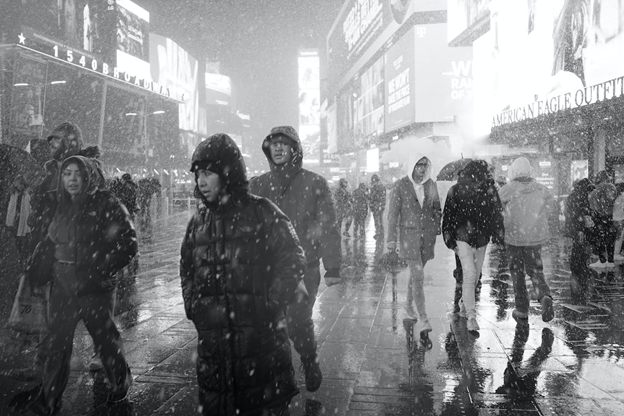Delving into the Spiritual Essence of Thunderstorms
Humankind has always been deeply moved by the undulating cadence of thunder and the stark, luminous dance of lightning across the skies. Because of their untamed and primal nature, thunderstorms have served as a rich source of spiritual symbolism throughout history, permeating a wide range of religions, cultures, and spiritual practices.
This article on the spiritual significance of thunderstorms seeks to reveal the profound and frequently contradictory meanings they have long held, serving as both prophets of doom and blessing and symbols of both forces of rebirth and destruction.
Table of Contents
- 1 Delving into the Spiritual Essence of Thunderstorms
- 2 Key Takeaways
- 3 Transformation and Renewal: Nature’s Catharsis
- 4 Harnessing the Energy of Thunderstorms in Rituals
- 5 Thunderstorms in Modern Spirituality
- 6 Nature’s Orchestra: Sound, Vibration, and Resonance
- 7 FAQs
- 8 References
- 9 Deep Blue Mystique: Why a Lapis Stone Necklace Is Your New Must-Have

Key Takeaways
- With their formidable power, thunderstorms have been perceived as conveyers of divine wrath, delivering destruction and upheaval in their wake.
- Simultaneously, they bear blessings, as the rain rejuvenates the earth, symbolizing nourishment, life, and divine favor.
- From Thor in Norse mythology to Indra in Hindu beliefs, deities associated with thunderstorms have played crucial roles in myths, often wielding power, judgment, and bestowing fertility.
- In folklores across the globe, thunderstorms have been characters in their own right, often involving tales of moral lessons, where the storms either admonish or reward human behaviors.
Thunderstorms in Mythology and Folklore
Plunge into the annals of mythology and folklore reveals a vast array of narratives where thunderstorms are both formidable protagonists and evocative settings. Across epochs and civilizations, stories have blossomed, painting thunderstorms as divine chariots, embodying gods’ voices, and shaping destinies.
- Mythical Representations:
- Greek Mythology: Zeus, wielding his thunderbolts, exemplifies a classic representation of thunderstorms symbolizing supreme power and authority.
- Japanese Folklore: Raijin, the god of thunder, lightning, and storms, is often depicted creating thunder with his drums, dictating nature’s rhythms and cycles.

Thunderstorms as Symbols of Divine Power
Thunderstorms, with their mighty roar and spectacular visuals, have often been intertwined with perceptions of divine communication, signaling power, anger, or even benevolence.
- Signals and Omens:
- Anger and Warning: Frequently, thunderstorms are perceived as expressions of divine dissatisfaction, warning or reprimanding mortals.
- Sustenance and Mercy: Alternatively, they can also represent merciful provision, where rain nourishes the land and ensures fertility and abundance.
Transformation and Renewal: Nature’s Catharsis
Within the tumultuous embrace of a thunderstorm, a compelling symbolism of transformation and renewal emerges, painting these natural phenomena as potent vehicles for catharsis and change. Thunderstorms often dismantle and disrupt, clearing paths for regeneration and new growth, thereby inherently linking them to cycles of death and rebirth, endings, and fresh beginnings.
- Cleansing and Purification:
- Purging the Old: The destructive aspect of thunderstorms symbolizes the purging of stagnant energies, beliefs, or situations.
- Nurturing the New: Following this purification, the nurturing rains foster new life and possibilities, symbolizing rebirth and renewal.

The Calm After the Storm: Rebirth and Renewal
The profound calm and freshness permeating the atmosphere after a thunderstorm carry poignant spiritual symbolism of rebirth and renewal. The air, cleansed of impurities, and the land, nourished by the heavens, epitomize a clean slate, offering an almost tangible sense of starting anew.
- Symbolism and Interpretation:
- Release and Relief: The calm post-storm symbolizes release, as the tensions and energies have been expended, providing relief and serenity.
- Hope and Possibility: This tranquil clarity is often seen as a fertile ground for new opportunities, ideas, and journeys, embodying hope and potential.

Harnessing the Energy of Thunderstorms in Rituals
The unfettered energy discharged during a thunderstorm has not only been a subject of fascination but also seen as a potent source to be harnessed in various spiritual and ritualistic practices across cultures. Navigating through historical and contemporary paths, thunderstorms have often been integrated into rituals, either to channel their raw, chaotic energy into constructive forms or to shield against their perceived destructiveness.
- Ritualistic Uses:
- Power and Energy: Thunderstorms bring a palpable energy, which is believed to amplify the power of rituals and spells in various traditions.
- Protection and Warding: Rituals often seek to harness thunderstorms’ energy for protection, utilizing their fierce essence as a shield against negativity.

Protective Measures: Ancient Rituals and Beliefs
An exploration into the ancient beliefs surrounding thunderstorms reveals a plethora of rituals and practices designed to provide protection against their tumultuous energy.
- Amulets and Talismans:
- Thor’s Hammer: In Norse traditions, amulets representing Thor’s hammer were utilized to protect against lightning and thunder.
- Protective Symbols: Various cultures employed symbols, written charms, and amulets to shield from the might of thunderstorms.
- Rituals and Actions:
- Prayers: Invocations and prayers were often uttered to appease the gods of thunder and seek protection during storms.
- Ritual Actions: Certain actions, like covering mirrors or extinguishing fires, were taken to safeguard against lightning strikes and ill omens.

Thunderstorms in Modern Spirituality
In the contemporary spiritual paradigm, thunderstorms continue to be a rich source of symbolism, inspiration, and practice. Modern spirituality often sees a melding of ancient beliefs with newer understandings and interpretations.
- Contemporary Practices:
- Mindfulness: Engaging with thunderstorms through mindful observation and meditation, using the sensory experiences as a focus point.
- Energy Work: Channeling the energetic ambiance of thunderstorms into personal or spatial energy cleansing and amplification.

Meditation and Mindfulness During Thunderstorms
In the realm of modern spirituality, thunderstorms serve as a powerful catalyst for deep meditation and mindfulness practices. The rolling thunder, vibrant flashes of lightning, and rhythmic drumming of raindrops provide a rich sensory experience that draws individuals into the present moment.
- Meditative Techniques:
- Sound Meditation: Using the diverse and dynamic sounds of the storm as a focus for meditation, immersing oneself in the natural symphony.
- Visualization: Utilizing the imagery of the cleansing rain and potent lightning as metaphors in visualization meditations for purification and empowerment.

Nature’s Orchestra: Sound, Vibration, and Resonance
The resonating sounds that bellow from a thunderstorm, ranging from the gentle pitter-patter of rain to the formidable roars of thunder, have often been likened to nature’s orchestra, a symphony that enwraps listeners in a cocoon of visceral and vibrational experiences.
- Sound and Spirituality:
- Natural Resonance: The sounds during a thunderstorm are seen as connecting points to the rhythms of nature, aligning internal energies with the external environment.
- Vibration and Energy: The vibrations resulting from thunder are believed to have an energizing and cleansing effect on spaces and beings.
Lightning: The Flash of Insight and Enlightenment
Lightning, with its sudden and intense manifestation, has symbolically been associated with flashes of insight, enlightenment, and divine intervention across various cultural narratives and spiritual perspectives.
- Symbolic Meanings:
- Divine Message: Lightning is often seen as a conveyer of divine messages or interventions, bringing stark revelations in its wake.
- Transformation: The piercing quality of lightning symbolizes breakthroughs, transformative moments that alter perceptions and understandings.

FAQs
What are common spiritual beliefs associated with thunderstorms across cultures?
Thunderstorms have been embroiled in spiritual and cultural narratives since time immemorial, being both feared and revered for their magnificent, yet occasionally destructive, powers.
- Power and Omnipotence:
- Cultures often associate thunderstorms with the might of divine beings, where thunder is seen as the voice of the gods and lightning their celestial power.
- Cleansing and Renewal:
- The rain that comes with thunderstorms is frequently symbolized as a form of cleansing, washing away the old to make way for the new, and nourishing the earth to facilitate growth.
- Chaos and Disruption:
- The violent nature of thunderstorms can symbolize chaos and disruption, representing upheaval and change within spiritual journeys.

How have thunderstorms influenced religious texts and scriptures?
In religious texts and scriptures, thunderstorms have often been depicted as mechanisms through which divine beings express their will, displeasure, or benevolence towards humanity.
- Expressions of Divine Will:
- Stories like those of Thor in Norse mythology, Zeus in Greek mythology, and Indra in Hindu mythology depict thunderstorms as tools utilized by gods to exhibit power and enforce will.
- Omens and Prophesies:
- In various texts, the occurrence of a thunderstorm is considered an omen or part of a prophecy, symbolizing divine intervention or forewarning.
Are there rituals or practices to harness the energy of thunderstorms for spiritual growth?
The potent energy of thunderstorms has been harnessed in numerous rituals and practices, aiming to tap into this vibrant and powerful natural phenomenon for spiritual expansion and exploration.
- Rituals During Storms:
- Some traditions involve conducting rituals during thunderstorms to amplify intentions, utilizing the storm’s energy for manifestation and empowerment.
- Meditative Practices:
- Engaging in meditation during a thunderstorm, utilizing the sounds and energies to deepen the practice and enhance internal exploration.

What do recurring thunderstorms symbolize in dreams or visions?
Recurring thunderstorms in dreams or visions can be rich in symbolic meaning, often embodying themes of change, disruption, cleansing, or emotional release, depending on the context and emotions experienced during the vision.
- Inner Turmoil or Emotional Release:
- Recurring storms can symbolize ongoing inner conflict or the need for emotional release and expression.
- Impending Change:
- Regularly envisioning thunderstorms might symbolize upcoming changes or upheavals, signaling a period of transition and transformation.

How can one attune themselves to the rhythms of nature during a thunderstorm?
Attuning oneself to the rhythms of a thunderstorm involves a mixture of mindfulness, openness, and a willingness to engage with the natural energies and vibrations present during the storm.
- Mindful Observation:
- Engaging in mindful observation, paying attention to the sights, sounds, and feelings elicited during a thunderstorm, and allowing oneself to be present and immersed in the experience.
- Engagement with Elements:
- Actively engaging with the elements, whether through mindful walks in the rain or meditating to the sound of thunder, helps forge a connection with the rhythms of the storm.
References
Caldecott, Ralph. “Thunder: Perfect Mind: A New Translation and Introduction.” (2011).
“Tales of Raijin and Raiju: Storm Myths in Japanese Culture.” (2007).
Leave a Reply